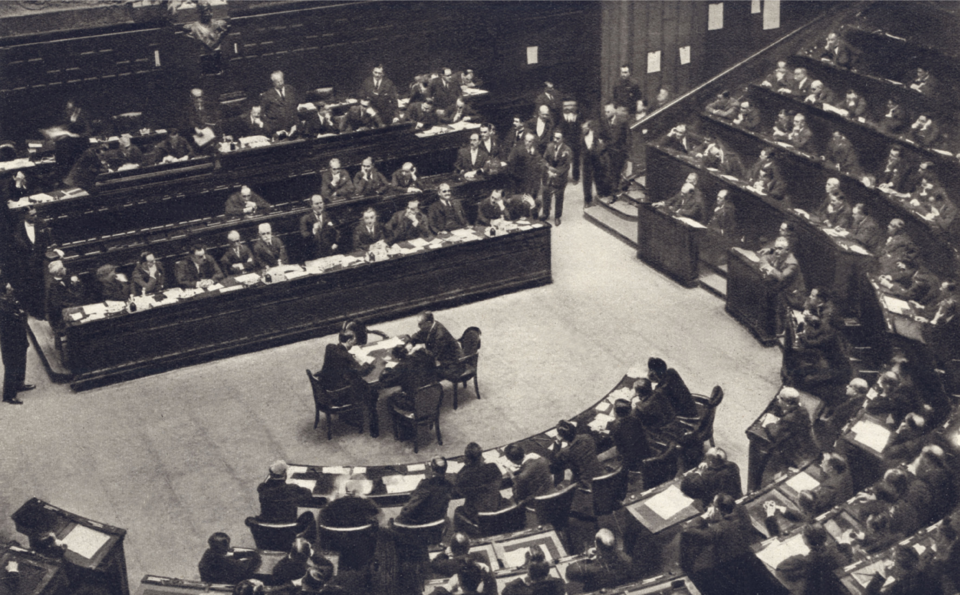OCR Specification focus:
‘the transition of Mussolini from prime minister to Duce; the Acerbo law and the murder of Matteotti.’
Mussolini’s rise from fragile premier to unquestioned Duce reveals the interplay of legal manipulation, political violence, and propaganda shaping Italy’s transformation into dictatorship.
Mussolini Becomes Prime Minister in 1922
When Benito Mussolini was appointed Prime Minister in October 1922, following the March on Rome, his position was precarious. His Fascist Party controlled only around 35 seats in the Chamber of Deputies, far from a majority. King Victor Emmanuel III had chosen Mussolini partly to avoid civil war, but parliamentary support was uncertain. Mussolini needed to transform his weak authority into a more stable and permanent control.
Challenges Mussolini Faced
Limited parliamentary base meant dependence on coalitions.
Violence by Fascist squads threatened legitimacy but kept opponents fearful.
Opposition parties such as Socialists and Catholics remained significant.
The monarchy still held constitutional powers and could dismiss him.
Mussolini’s strategy was therefore to strengthen Fascism’s position legally and politically, while simultaneously employing intimidation.
The Acerbo Law, 1923
One of Mussolini’s first major steps was the introduction of the Acerbo Law in 1923, named after its sponsor, Giacomo Acerbo.
Acerbo Law: An electoral law passed in 1923 stating that the party with the largest share of votes (provided it gained at least 25%) would automatically receive two-thirds of seats in the Chamber of Deputies.
This law was designed to end the instability of proportional representation and ensure Fascist dominance in parliament.
Passage of the Law
The Acerbo Law passed with broad support, not just from Fascists, because:
Liberal elites hoped it would bring stability.
Intimidation by Fascist squads in parliament discouraged opposition.
The King and Senate supported it as a safeguard against socialism.
As a result, in the 1924 elections, the Fascists and their allies gained nearly 65% of the vote, which under the Acerbo system translated into overwhelming control of parliament.
The 1924 Elections
The April 1924 election was marked by extensive violence, intimidation, and fraud. Fascist squadristi targeted opponents, suppressed campaigning, and manipulated results. Despite this, Mussolini claimed the victory confirmed the legitimacy of Fascist rule. The Acerbo Law ensured Fascism’s dominance regardless of the true scale of popular support.
The Acerbo Law (1923) awarded two-thirds of Chamber seats to the largest national list if it secured at least 25% of the vote, enabling the National List to dominate the 1924 election.

Seat apportionment after the 1924 election. The diagram makes clear how the Acerbo Law translated the National List’s vote into a commanding share of seats. This directly supports analysis of the law’s mechanical effects on parliamentary arithmetic. Source
The Murder of Matteotti
The growing violence culminated in the murder of Giacomo Matteotti, leader of the Socialist Unity Party, in June 1924.
Giacomo Matteotti: Italian socialist politician who openly denounced electoral corruption and Fascist violence in parliament; kidnapped and murdered by Fascist thugs in 1924.
Matteotti’s murder caused a political crisis. He had delivered a damning speech accusing Fascists of electoral fraud, after which he was abducted and killed. The event shocked Italy and the world.
On 10 June 1924, Giacomo Matteotti was abducted and murdered by Fascist squadristi days after denouncing electoral violence and fraud, turning a simmering legitimacy crisis into a national outrage.
Consequences of the Murder
Public outrage led many to expect Mussolini’s resignation.
Opposition deputies withdrew from parliament in protest, in the so-called Aventine Secession.
The King, however, refused to act against Mussolini, fearing instability and socialism more than Fascism.
This royal inaction gave Mussolini critical breathing space.
Mussolini’s January 1925 Speech
In January 1925, Mussolini delivered a decisive speech in parliament. He assumed political responsibility for Fascist violence but framed it as necessary to protect Italy from chaos. This bold move marked a turning point: instead of retreating, Mussolini moved to consolidate dictatorship.
On 3 January 1925, Mussolini delivered a defiant address in the Chamber of Deputies, assuming “political, moral and historical” responsibility for the climate that produced political violence and promising order “with love if possible, with force if necessary”.

Mussolini speaking in the Chamber of Deputies, 1925. The image captures the parliamentary arena in which he converted a political crisis into an authoritarian consolidation. It supports discussion of the January speech that accelerated Italy’s transition to dictatorship. Source
Shift Towards Dictatorship
From early 1925 onwards, Mussolini systematically dismantled parliamentary democracy:
Press censorship tightened.
Opposition parties were harassed and weakened.
Fascist control over local government expanded.
Mussolini increasingly styled himself as Il Duce, emphasising authoritarian leadership.
The combination of the Acerbo Law, electoral manipulation, and the Matteotti crisis allowed Mussolini to shift from precarious premier to authoritarian ruler.
Key Themes and Historical Importance
Legal manipulation: The Acerbo Law gave a façade of legitimacy to Fascist dominance.
Political violence: Fascist squadristi reinforced control through fear and suppression.
Royal complicity: Victor Emmanuel III’s reluctance to act enabled Mussolini’s survival.
Turning point: Matteotti’s murder, instead of destroying Mussolini, provided the opportunity to consolidate power.
How Mussolini Became Duce
Mussolini’s transition from Prime Minister to Duce can be understood as a staged process:
Appointment in 1922 due to royal compromise.
Acerbo Law ensuring electoral dominance.
Violent suppression of opposition and fraudulent elections.
Matteotti crisis turning into an opportunity.
January 1925 declaration paving the way for dictatorship.
By 1925, Mussolini had moved decisively from being a fragile coalition premier to a dictatorial leader, setting the stage for the Fascist regime’s consolidation and Italy’s transformation into a one-party state.
FAQ
Many liberal and conservative deputies believed the law would end the instability of proportional representation. They thought Mussolini’s movement could bring order after years of strikes and parliamentary deadlock.
Others supported it because they feared socialism more than Fascism, seeing Mussolini as a safeguard against revolution. Intimidation by Fascist squads in parliament also discouraged open opposition.
The Aventine Secession saw opposition deputies withdraw from parliament after Matteotti’s murder in protest. Their aim was to isolate Mussolini and force the King to dismiss him.
Instead, their absence left Mussolini with fewer opponents inside parliament, making it easier for him to dominate proceedings. It also allowed him to present himself as the only figure capable of guaranteeing national stability.
King Victor Emmanuel III refused to dismiss Mussolini or use emergency powers against the Fascists. His decision stemmed from fear of civil unrest and socialism gaining strength.
The King also valued Mussolini’s ability to control the Fascist squads, which otherwise might turn their violence against the monarchy itself. This inaction effectively ensured Mussolini’s survival during the crisis.
The January 1925 speech strengthened Mussolini’s control over the Fascist Party. By taking responsibility for violence, he silenced internal critics who worried about public backlash.
It also allowed Mussolini to reframe the movement’s image: violence was presented as necessary for safeguarding Italy. From this point, Mussolini positioned himself not just as party leader but as the embodiment of Fascism itself.
Mussolini used press control to minimise coverage of Fascist wrongdoing and to emphasise themes of national unity and strength.
He portrayed Fascist violence as patriotic and necessary for Italy’s survival. Newspapers under Fascist influence framed opponents as weak or unpatriotic.
Public speeches and rallies further reinforced his authority, turning a scandal into a narrative of Mussolini as the only leader capable of restoring order.
Practice Questions
Question 1 (2 marks)
What was the main purpose of the Acerbo Law introduced in 1923?
Mark Scheme
1 mark for identifying that it aimed to give the largest party in an election two-thirds of the seats in the Chamber of Deputies.
1 mark for explaining that this would ensure stability and secure Fascist dominance.
Question 2 (6 marks)
Explain how the murder of Giacomo Matteotti contributed to Mussolini’s transition from prime minister to Duce.
Mark Scheme
Up to 2 marks for outlining the event: Matteotti denounced electoral fraud and was murdered by Fascist thugs in June 1924.
Up to 2 marks for describing the political consequences: public outrage, the Aventine Secession by opposition deputies, and a crisis of legitimacy.
Up to 2 marks for explaining why Mussolini benefited: King Victor Emmanuel III’s refusal to act, Mussolini’s January 1925 speech taking responsibility, and the opportunity it gave him to consolidate dictatorship.

